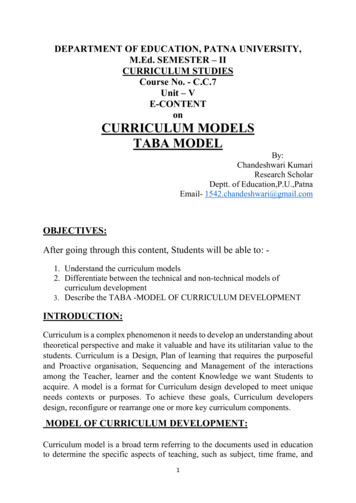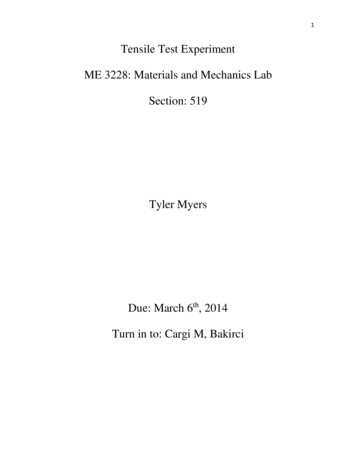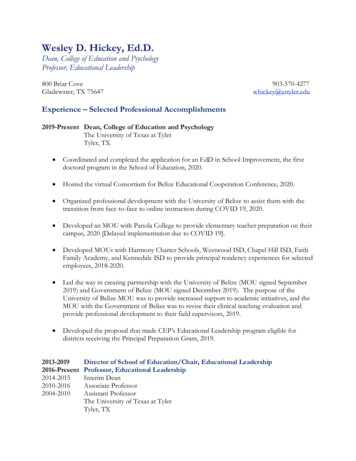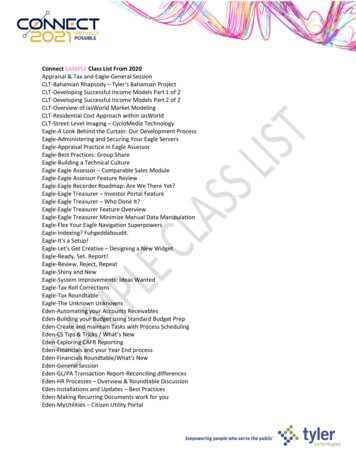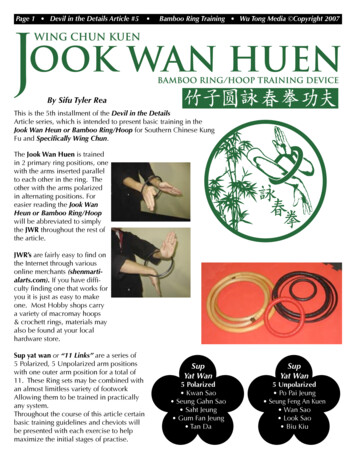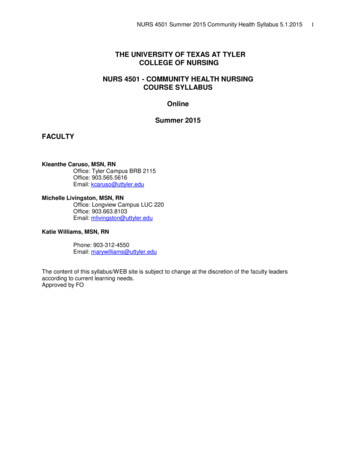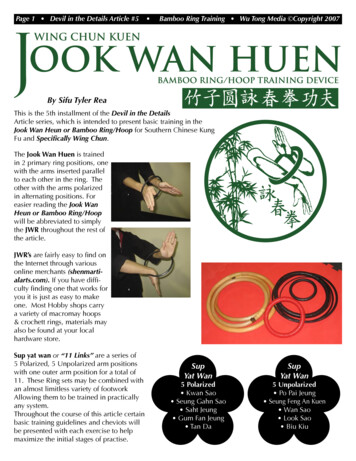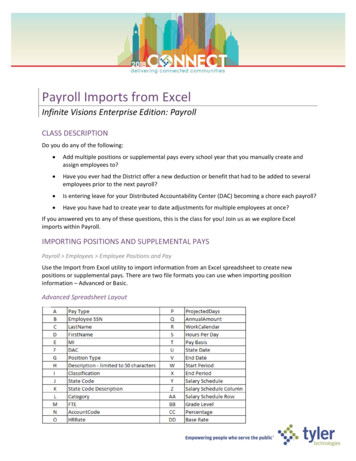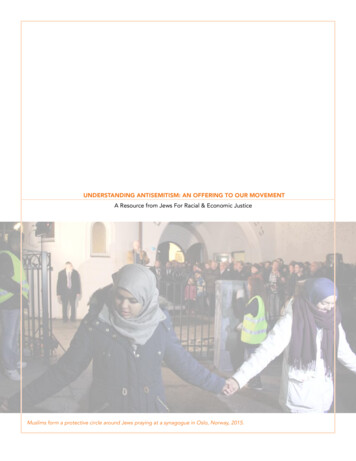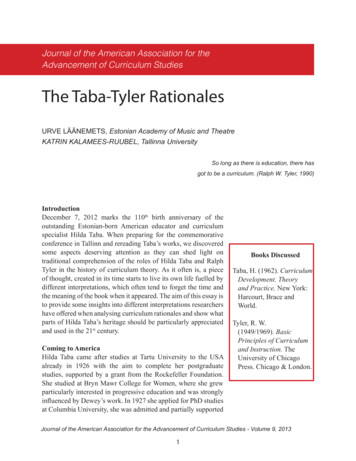
Transcription
Journal of the American Association for theAdvancement of Curriculum StudiesThe Taba-Tyler RationalesURVE LÄÄNEMETS, Estonian Academy of Music and TheatreKATRIN KALAMEES-RUUBEL, Tallinna UniversitySo long as there is education, there hasgot to be a curriculum. (Ralph W. Tyler, 1990)IntroductionDecember 7, 2012 marks the 110th birth anniversary of theoutstanding Estonian-born American educator and curriculumspecialist Hilda Taba. When preparing for the commemorativeconference in Tallinn and rereading Taba’s works, we discoveredsome aspects deserving attention as they can shed light ontraditional comprehension of the roles of Hilda Taba and RalphTyler in the history of curriculum theory. As it often is, a pieceof thought, created in its time starts to live its own life fuelled bydifferent interpretations, which often tend to forget the time andthe meaning of the book when it appeared. The aim of this essay isto provide some insights into different interpretations researchershave offered when analysing curriculum rationales and show whatparts of Hilda Taba’s heritage should be particularly appreciatedand used in the 21st century.Coming to AmericaHilda Taba came after studies at Tartu University to the USAalready in 1926 with the aim to complete her postgraduatestudies, supported by a grant from the Rockefeller Foundation.She studied at Bryn Mawr College for Women, where she grewparticularly interested in progressive education and was stronglyinfluenced by Dewey’s work. In 1927 she applied for PhD studiesat Columbia University, she was admitted and partially supportedBooks DiscussedTaba, H. (1962). CurriculumDevelopment. Theoryand Practice. New York:Harcourt, Brace andWorld.Tyler, R. W.(1949/1969). BasicPrinciples of Curriculumand Instruction. TheUniversity of ChicagoPress. Chicago & London.Journal of the American Association for the Advancement of Curriculum Studies - Volume 9, 20131
by the Carneggie Endowment for International Peace. Taba’s scientific supervisor was WillaimH. Kilpatrick, the initiator of the project method. Taba’s doctoral dissertation, The Dynamics ofEducation: A Methodology of Progressive Educational Thought, was published as a book in 1932by Kegan Paul, Trench, Truber & CO. LTD in London.In 1931 Hilda Taba applied for a vacant professorship at Tartu University but despite herinternational experience and completed degree, she was not elected. She returned to the USAwhere she could work, study and develop professionally. Despite difficult beginning, she soon gotthe post of a German teacher in 1933, and later that of the director of curriculum at Dalton School,Ohio. Participation in the Eight-Year Study brought her together with Ralph Tyler, who was thehead of the project evaluation staff, and who in 1939 hired her as the coordinator of the socialstudies’ curriculum. In 1939 the project staff was transferred to the University of Chicago, whereHilda Taba worked as the director of the Curriculum Laboratory until 1945.In 1945 she became the director of the The Intergroup Education Project, launched in New YorkCity. The success of this experimental project led to the establishment of the Center of IntergroupEducation at the University of Chicago, which was headed by Taba in 1948–1951. In 1951–1967she was involved in reorganization and development of social studies curricula in Contra CostaCounty, in the San Francisco Bay area. At the same time she also became a full professor ofeducation at San Francisco State University and enjoyed recognition for her expertise in the areasof curriculum design, intergroup education, and development of students’ cognitive processes. Hereducational ideas are reflected in about 20 books, research reports and in over fifty articles she haspublished in education journals and yearbooks.Taba advocated for a flexible model of curriculum renewal based on joint efforts of practicingteachers, educational administrators and researchers. Her curriculum model covers many of thecritical topics, from aims and goals of education, the selection of the content, the process oforganizing learning and school development, and evaluation at different levels. Several generalprinciples and ideas of curriculum design developed by Hilda Taba belong to the foundations ofmodern curriculum theories.Her ideas were especially influential in 1960s–1970s, and are still frequently referred to by authorsof the 21st century. Her famous book Curriculum Development. Theory and Practice (1962) is stilla useful reading material for those making educational policy today. Taba’s general strategy fordeveloping students’ thinking through social studies curriculum have led to numerous projects fordevelopment of students critical thinking skills and learning with comprehension since 1970s upto the present days. Hilda Taba died unexpectedly on July 6, 1967 in Burlingame, CA at the peakof her academic capabilities and power.Perhaps in 2012 it would be timely to have a fresh look at some of the messages sent over thedecades by Hilda Taba, which would be of help when trying to find solutions to the problemseducational systems globally are facing today.Journal of the American Association for the Advancement of Curriculum Studies - Volume 9, 20132
Curriculum rationalesThere are two of them – that of Ralph Tyler and that of Hilda Taba. The longevity of Tyler’srationale can be explained by 36 reprintings of his 1949 Principles of Curriculum and Instruction.Tyler’s book was a product of the Eight-Year Study (1933–1941), a long-term research carriedout during the Great Depression the purpose of which was to evaluate the effects of progressiveeducation for university students by means of a comparison with traditional education. Tyler washired to evaluate the study.In Basic Principles of Curriculum and Instruction, Tyler stated his intention to “help the student ofeducation to understand more fully the kinds of problems involved in developing a curriculum andplan of instruction and to acquire some techniques by which these basic problems may be attacked.”(Tyler, 1949:1) He describes learning as taking place through the changed behavior of the student.Nowadays, it could be called a child- or learner-centred approach. Remiscient of Dewey, Tyler(1949:63) writes: “It is what he does that he learns, not what the teacher does.” Tyler’s classicalfour principles, or questions, which have to be answered for developing a curriculum – questionsabout educational aims, learning experience leading to the realization of those aims, organizationof instruction, and evaluation (ibid.:1) - were the accepted approach to curriculum developmentfor decades. They still guide the essential questions of curriculum development today, especiallyin educational systems with market economy based political orientations.The Taba Rationale is presented in her Curriculum Development. Theory and Practice of 1962. Itconsists of 7 steps:Step 1. Diagnosis of needsStep 2. Formulation of objectivesStep 3. Selection of contentStep 4. Organization of contentStep 5. Selection of learning experiencesStep 6. Organization of learning experiences (development of methods)Step 7. Determination of what to evaluate and how (Taba1962:12)At the bottom of the same page we can read: “These steps are comparable to a sequence proposedin a syllabus by Tyler (1950). A similar sequence is described by Taba” (1945). Here Taba refers toher work General Techniques of Curriculum Planning, published in National Society for the Studyof Education American Education in the Post-War Period: Curriculum reconstruction. Forty FourthYearbook Part 1. Ch. 5. When comparing just the two rationales it is difficult to ascertain whoborrowed from whom and when, but we have to admit the basic difference of the two curriculumdesign approaches, which has a critical meaning not only for researchers of modern times, but alsofor those developing curricula for current school praxis.DiscussionTyler’s model is deductive while Taba’s is inductive. Tyler’s approach argues from the administratorapproach while Taba’s reflects the teacher’s approach. In essence, Tyler believes that administrationJournal of the American Association for the Advancement of Curriculum Studies - Volume 9, 20133
should design the curriculum and the teachers implement it. Taba believes that the teachers are awareof the students needs; hence teachers should be the ones to develop the curriculum and implementin practice. Another name for Taba’s is the grass-roots approach. However, her rationale does notstart with objectives, as she believes that the demand for education in a particular society should bestudied first (see Step 1). Taba also pays attention to the selection of the content and its organizationwith an aim to provide students with an opportunity to learn with comprehension. Tyler lays themain stress on aims, evaluation and control. This approach may be perfect, perhaps, for marketoriented education, but inadequate for the development of responsible and creative individualsable to meet the challenges of the constantly changing circumstances. Many educational systemstoday, using Tyler’s model, have come to crises and require reforms based on a totally differentmodel of curriculum development.The Meaning of Tyler’s RationaleThe most detailed and analytical research on Tyler’s rationale and its meaning has been presentedin the voluminous study of Willaim Pinar and his colleagues (1996) entitled UnderstandingCurriculum. An Introduction to the Study of Historical and Contemporary Curriculum Discourses.Their conclusion was: the era of “curriculum development“ is past. There are those who will notaccept this argument. We predict than even a few of our friends will think this is “master narrative“,and that any effort to bring together differing discourses in one book, different people in one room,is authoritarian or patriarchal in principle. (Pinar et al, 1996:5)We live in a different time. True, in science and mathematics education, traditional curriculumdevelopment still occurs, as these privileged areas still receive significant amounts of federaland private grant monies. [---] However, the general field of curriculum, the field interestedin the relationships among the school subjects as well as issues within the individual schoolsubjects themselves and with the relationships between the curriculum and the world, that fieldis no longer preoccupied with development. As we shall see, the field today is preoccupiedwith understanding. (ibid.:6).Traditional curriculum theory has developed out of an “instrumental rationality”. This philosophicalperspective separates means from ends to maximize efficiency and effectiveness. Tyler’s rationale isan appropriate example of this approach. Tyler views curriculum theory as technical. Predeterminedbehavioral objectives serve as a driving force that controls the pedagogical and evaluative effortsthat follow. Tyler asserts the development of objectives is necessarily the first “step” in curriculumplanning “because they are the most critical criteria for guiding all the other activities of thecurriculum maker.” This formulation happens before the curriculum maker can “carry on all thefurther steps of curriculum planning” (ibid.:62). Tyler’s rationale has been challenged, but it seemsto have become stronger as a result. Indeed, its elegant simplicity is engaging.Taba’s contributionHilda Taba’s principles for curriculum development can be traced back to her doctoral thesis TheDynamics of Education. A Methodology of Progressive Educational Thought (1932), in which theTaba distinguishes between being and becoming in the development of a learner, his/her possibleJournal of the American Association for the Advancement of Curriculum Studies - Volume 9, 20134
creation of self and the dynamics in this lifelong process. The following ideas deserved particularattention then and still today: The task of education, as understood at present, is to lead growing individuals to more andmore intelligent, wide, well-organized, and rich forms of experience through guidance, throughselection of subject matter, and by providing an environment which is stimulating to selfdirection. (Taba, 1932:218) The idea that the conscious guidance of education must consider the all-round development ofthe individual has been an item of the educationist’s credo since Herbart. (ibid.:221) Habit formation, the acquisition of some fundamental vocational skills, education forcitizenship, and other similar functions today demand the serious attention of education. Butwhile the tasks of the school have thus multiplied, the principle governing the developmentof the curriculum has remained inherently unchanged, namely, the expansive addition of thesubjects and materials according to the growing needs of society. As every new objective forcesa new subject into the school curriculum, an extreme overcrowding has naturally resulted,followed by a disintegration and atomization of old and new fields of knowledge. (ibid.:235) The passive mastery of finished products of thought, in fact, drugs the creative and constructiveabilities of the learner. (ibid.:237) Education has done its best when it has been able to sensitize the minds of learners to thevariety of ways in which knowledge can be made productive, to the variety of methods for thetreatment of facts, to the various interpretations events may be given; and, finally, whwn it hasset the challengefor inquiry. (ibid.:238) Both subject matter and the process of education have to be so organized that within everyspecific task every student can apply his own method, can use different materials, and stillbe able to master or achieve what are regarded to be the common essentials in the objectives.(ibid.:241) There is a fundamental difference between major objectivities devoid of any specific qualitativecontent, which serve only as a guide in dealing with the formation of specific qualitativelypositive attitud
principles and ideas of curriculum design developed by Hilda Taba belong to the foundations of modern curriculum theories. Her ideas were especially influential in 1960s–1970s, and are still frequently referred to by authors of the 21st century. Her famous book Curriculum Development. Theory and Practice (1962) is File Size: 221KBPage Count: 12People also search forhilda taba concept developmenthilda taba concept developmenthilda taba curriculum development modelhilda taba curriculum model
